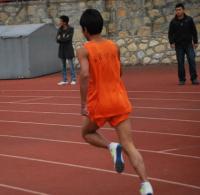Posts Tagged ‘sports injury’
What is causing pain at the front of my knee?
Many athletes and recreational sports people suffer from on-going knee pain and soreness. Today Physiotherapist Sarah Marshall looks in more detail at one aspect.
One of the most common types is Anterior Knee Pain (AKP). It describes pain at the front of the knee and can affect up to 40% of the population. It is especially common amongst athletes, yet not disrupt their sporting function or ability.
Read More5 Tenets of Sports Injury Rehabilitation
Movement is the foundation of sports injury rehabilitation Dr Grace Golden gave an insightful presentation on returning to sporting activity at GAIN 2018. I liked her systematic approach which was well illustrated with video examples. She also had a large amount of creativity and fun involved in her rehabilitation sessions. Coaching the injured athlete Grace…
Read MoreReconditioning athletes: Bill Knowles seminar
“An exercise is something you do a movement is something you feel.” Was the title of Bill Knowles’ seminar on rehabilitating (reconditioning in his terms) athletes from sports injuries. The question he asks himself is “what’s in the best interest of the athlete?” This often means pulling the athlete out of the injured body and…
Read MoreLet your child play sport rather than just compete
Children need to play more and compete less Children who get injured or burntout may be competing at sport too much and have too little opportunity to just play. These words on shoulder operations by Hall of Fame baseball player John Smoltz ring very true. “I want to encourage the families and parents that are…
Read MoreHow can I stop my child getting injured?
The evidence is quite stark if your child is spending too much time in organised activity rather than free play, if they have specialised in one sport and if they have gone through their growth spurt, then they are more likely to get injured (1).
Read MoreHow to reduce the risk of ACL injury for females.
“Female athletes have a 4-6 times higher incidence of ACL injury than do male athletes participating in the same landing and pivoting sports” (1)
Why are Females at Higher Risk of ACL Injury?
Hormonal changes: Hormonal changes during the menstrual cycle can have a direct effect on neuro-muscular performance.
Read MorePlanned Performance Training: Bill Knowles
Envelope of healing
The upper limit of the envelope is for the elite athlete, but too much work leads to inflammation. Too little work is safer, but it is not causing enough adaptability.
There are no time frames for the rehab procedures, instead criteria based progressions are needed
PRICE Guidelines for injury treatment
Current recommendations on treating injuries
After witnessing the aftermath of the parents’ races at my daughters’ school sports day last week, I decided to review the current Executive Summary of the Management of Acute Soft Tissue Protection, Rest, Ice, Compression and Elevation (PRICE) by the Association of Chartered Physiotherapists in Sports and Exercise medicine (ACPSM).
Read MoreShoulder pain- how to get it better
In response to Tommy’s question about persistent shoulder pain.
If you have shoulder pain, then there are a few things you need to do:
Diagnosis- what is actually wrong with it? Going to the GP and being told to rest and given some anti inflammatories may work in the immediate future, but not necessarily in the long term.
Read MoreHow to manage “Growing pains”
A guide to common growing pains in athletes
 Children and adolescents endure many of the same injuries and mechanical dysfunctions as adults. However, in the maturing skeleton there are some specific conditions that are only seen in the young.
Children and adolescents endure many of the same injuries and mechanical dysfunctions as adults. However, in the maturing skeleton there are some specific conditions that are only seen in the young.
Here is an overview of the common conditions, their causes and how to manage them.
Read More


